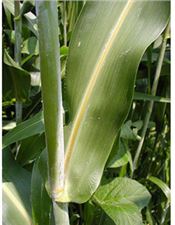Project To Determine How Quickly Sorghum-Sudangrass Varieties Return Nutrients To The Soil
PRINCETON, KEN.
A University of Kentucky student is studying whether sorghum- sudangrass with a brown midrib trait adds nutrients back to soil quicker than varieties without the trait.
Sorghum-sudangrass is a warm-season annual grass Kentucky producers use for summer grazing and pasture renovation. When livestock graze the forage, they leave behind plant residues on top of the soil that must decompose.
Previous studies have shown that sorghum-sudangrass containing the brown midrib trait has less lignin than other varieties. As a result, microbes in livestock’s rumen digest the forage more completely, which enhances the animal’s performance. UK College of Agriculture Food and Environment forage researchers think the trait may also speed up leftover plant residue decomposition.
“We think that macro and micro flora and fauna in and at the soil surface may also be able to digest sorghum-sudangrass with the brown midrib trait quicker, which would speed up decomposition,” said Brandon Dooley, a UK senior who interned this summer with Chris Teutsch, UK extension forage specialist. “More rapid decomposition could allow nutrients, carbon and organic matter to return to the soil quicker.”
Dooley, a geography major in the UK College of Arts and Sciences, interned with Teutsch through the U.S. Department of Agriculture’s Research and Extension Experiential Learning for Undergraduates summer internship program.
At the UK Grain and Forage Center of Excellence in Princeton, Dooley placed harvested pieces of sorghum-sudangrass in bags constructed of a porous shade cloth that allowed insects and microorganisms access to the plant residue. The bags, which contained either plant leaves, stems or both, remained on the soil surface from one to 16 weeks. At predetermined times, researchers collected the bags and dried and weighed the remaining contents. They estimated decomposition rates by subtracting the remaining dry matter from the original amount placed in the bag. The final collection date is scheduled for late November.
“Understanding how the BMR trait impacts decomposition rates in pastures will allow producers to make informed decisions on how these varieties might fit into the grazing systems on their farms,” said Teutsch, forage extension specialist at the UK Research and Education Center at Princeton.
Researchers will present results from the study at the American Forage and Grassland Council’s annual conference in January in Wichita, Kansas.
This material is based upon work that is supported by the National Institute of Food and Agriculture, U.S. Department of Agriculture, under award number 2018-67032-27710. USDA is an equal opportunity employer and service provider. Any opinions, findings, conclusions, or recommendations expressed in this publication are those of the author(s) and do not necessarily reflect the view of the U.S. Department of Agriculture. ∆

The brown midrib trait (BMR) found in sorghum species is an outward expression of a mutation that results in lower levels of lignin in the plant. Lower concentrations of lignin result in improved forage digestibility and animal performance. UK researchers suspect that it also helps nutrients return to the soil quicker.